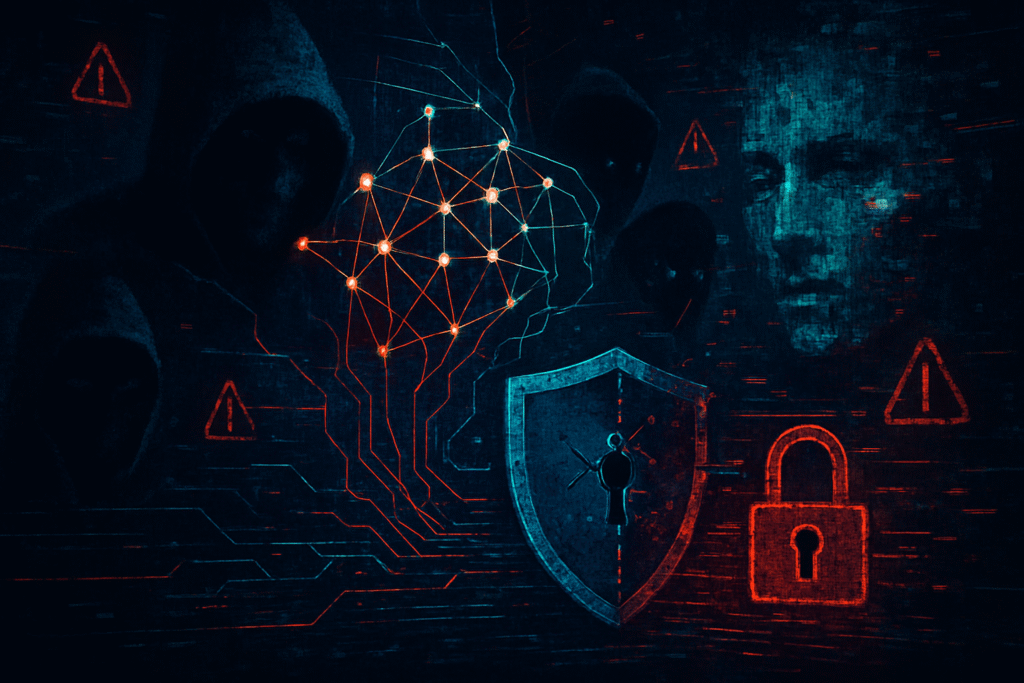
Chicago, IL – October 21, 2025 – The cybersecurity landscape is bracing for an unprecedented surge in AI-driven threats, according to the pivotal ISACA 2026 Tech Trends and Priorities Report. Based on a comprehensive survey of nearly 3,000 digital trust professionals conducted in late 2025, the findings paint a stark picture: AI-driven social engineering has emerged as the leading cyber fear for the coming year, surpassing traditional concerns like ransomware. This marks a significant shift in the threat paradigm, demanding immediate attention from organizations worldwide.
Despite the escalating threat, the report underscores a critical chasm in organizational preparedness. A mere 13% of global organizations feel "very prepared" to manage the risks associated with generative AI solutions. This alarming lack of readiness, characterized by underdeveloped governance frameworks, inadequate policies, and insufficient training, leaves a vast majority of enterprises vulnerable to increasingly sophisticated AI-powered attacks. The disconnect between heightened awareness of AI's potential for harm and the slow pace of implementing robust defenses poses a formidable challenge for cybersecurity professionals heading into 2026.
The Evolving Arsenal: How AI Supercharges Cyber Attacks
The ISACA 2026 report highlights a profound transformation in the nature of cyber threats, driven by the rapid advancements in artificial intelligence. Specifically, AI's ability to enhance social engineering tactics is not merely an incremental improvement but a fundamental shift in attack sophistication and scale. Traditional phishing attempts, often recognizable by grammatical errors or generic greetings, are being replaced by highly personalized, contextually relevant, and linguistically flawless communications generated by AI. This leap in quality makes AI-powered phishing and social engineering attacks significantly more challenging to detect, with 59% of professionals acknowledging this increased difficulty.
At the heart of this technical evolution lies generative AI, particularly large language models (LLMs) and deepfake technologies. LLMs can craft persuasive narratives, mimic specific writing styles, and generate vast quantities of unique, targeted messages at an unprecedented pace. This allows attackers to scale their operations, launching highly individualized attacks against a multitude of targets simultaneously, a feat previously requiring immense manual effort. Deepfake technology further exacerbates this by enabling the creation of hyper-realistic forged audio and video, allowing attackers to impersonate individuals convincingly, bypass biometric authentication, or spread potent misinformation and disinformation campaigns. These technologies differ from previous approaches by moving beyond simple automation to genuine content generation and manipulation, making the 'human element' of detection far more complex.
Initial reactions from the AI research community and industry experts underscore the gravity of these developments. Many have long warned about the dual-use nature of AI, where technologies designed for beneficial purposes can be weaponized. The ease of access to powerful generative AI tools, often open-source or available via APIs, means that sophisticated attack capabilities are no longer exclusive to state-sponsored actors but are within reach of a broader spectrum of malicious entities. Experts emphasize that the speed at which these AI capabilities are evolving necessitates a proactive and adaptive defense strategy, moving beyond reactive signature-based detection to behavioral analysis and AI-driven threat intelligence.
Competitive Implications and Market Dynamics in the Face of AI Threats
The escalating threat landscape, as illuminated by the ISACA 2026 poll, carries significant competitive implications across the tech industry, particularly for companies operating in the AI and cybersecurity sectors. Cybersecurity firms specializing in AI-driven threat detection, behavioral analytics, and deepfake identification stand to benefit immensely. Companies like Palo Alto Networks (NASDAQ: PANW), CrowdStrike Holdings (NASDAQ: CRWD), and SentinelOne (NYSE: S) are likely to see increased demand for their advanced security platforms that leverage AI and machine learning to identify anomalous behavior and sophisticated social engineering attempts. Startups focused on niche areas such as AI-generated content detection, misinformation tracking, and secure identity verification are also poised for growth.
Conversely, major tech giants and AI labs, including Google (NASDAQ: GOOGL), Microsoft (NASDAQ: MSFT), and Meta Platforms (NASDAQ: META), face a dual challenge. While they are at the forefront of developing powerful generative AI tools, they also bear a significant responsibility for mitigating their misuse. Their competitive advantage will increasingly depend not only on the capabilities of their AI models but also on the robustness of their ethical AI frameworks and the security measures embedded within their platforms. Failure to adequately address these AI-driven threats could lead to reputational damage, regulatory scrutiny, and a loss of user trust, potentially disrupting existing products and services that rely heavily on AI for user interaction and content generation.
The market positioning for companies across the board will be heavily influenced by their ability to adapt to this new threat paradigm. Organizations that can effectively integrate AI into their defensive strategies, offer comprehensive employee training, and establish strong governance policies will gain a strategic advantage. This dynamic is likely to spur further consolidation in the cybersecurity market, as larger players acquire innovative startups with specialized AI defense technologies, and will also drive significant investment in research and development aimed at creating more resilient and intelligent security solutions. The competitive landscape will favor those who can not only innovate with AI but also secure it against its own weaponized potential.
Broader Significance: AI's Dual-Edged Sword and Societal Impacts
The ISACA 2026 poll's findings underscore the broader significance of AI as a dual-edged sword, capable of both unprecedented innovation and profound societal disruption. The rise of AI-driven social engineering and deepfakes fits squarely into the broader AI landscape trend of increasing sophistication in autonomous and generative capabilities. This is not merely an incremental technological advancement but a fundamental shift that empowers malicious actors with tools previously unimaginable, blurring the lines between reality and deception. It represents a significant milestone, comparable in impact to the advent of widespread internet connectivity or the proliferation of mobile computing, but with a unique challenge centered on trust and authenticity.
The immediate impacts are multifaceted. Individuals face an increased risk of financial fraud, identity theft, and personal data compromise through highly convincing AI-generated scams. Businesses confront heightened risks of data breaches, intellectual property theft, and reputational damage from sophisticated, targeted attacks that can bypass traditional security measures. Beyond direct cybercrime, the proliferation of AI-powered misinformation and disinformation campaigns poses a grave threat to democratic processes, public discourse, and social cohesion, as highlighted by earlier ISACA research indicating that 80% of professionals view misinformation as a major AI risk.
Potential concerns extend to the erosion of trust in digital communications and media, the potential for AI to exacerbate existing societal biases through targeted manipulation, and the ethical dilemmas surrounding the development and deployment of increasingly powerful AI systems. Comparisons to previous AI milestones, such as the initial breakthroughs in machine learning for pattern recognition, reveal a distinct difference: current generative AI capabilities allow for creation rather than just analysis, fundamentally altering the attack surface and defense requirements. While AI offers immense potential for good, its weaponization for cyber attacks represents a critical inflection point that demands a global, collaborative response from governments, industry, and civil society to establish robust ethical guidelines and defensive mechanisms.
Future Developments: A Race Between Innovation and Mitigation
Looking ahead, the cybersecurity landscape will be defined by a relentless race between the accelerating capabilities of AI in offensive cyber operations and the innovative development of AI-powered defensive strategies. In the near term, experts predict a continued surge in the volume and sophistication of AI-driven social engineering attacks. We can expect to see more advanced deepfake technology used in business email compromise (BEC) scams, voice phishing (vishing), and even video conferencing impersonations, making it increasingly difficult for human users to discern authenticity. The integration of AI into other attack vectors, such as automated vulnerability exploitation and polymorphic malware generation, will also become more prevalent.
On the defensive front, expected developments include the widespread adoption of AI-powered anomaly detection systems that can identify subtle deviations from normal behavior, even in highly convincing AI-generated content. Machine learning models will be crucial for real-time threat intelligence, predicting emerging attack patterns, and automating incident response. We will likely see advancements in digital watermarking and provenance tracking for AI-generated media, as well as new forms of multi-factor authentication that are more resilient to AI-driven impersonation attempts. Furthermore, AI will be increasingly leveraged to automate security operations centers (SOCs), freeing human analysts to focus on complex, strategic threats.
However, significant challenges need to be addressed. The "AI vs. AI" arms race necessitates continuous innovation and substantial investment. Regulatory frameworks and ethical guidelines for AI development and deployment must evolve rapidly to keep pace with technological advancements. A critical challenge lies in bridging the skills gap within organizations, ensuring that cybersecurity professionals are adequately trained to understand and combat AI-driven threats. Experts predict that organizations that fail to embrace AI in their defensive posture will be at a severe disadvantage, emphasizing the need for proactive integration of AI into every layer of the security stack. The future will demand not just more technology, but a holistic approach combining AI, human expertise, and robust governance.
Comprehensive Wrap-Up: A Defining Moment for Digital Trust
The ISACA 2026 poll serves as a critical wake-up call, highlighting a defining moment in the history of digital trust and cybersecurity. The key takeaway is unequivocal: AI-driven social engineering and deepfakes are no longer theoretical threats but the most pressing cyber fears for the coming year, fundamentally reshaping the threat landscape. This unprecedented sophistication of AI-powered attacks is met with an alarming lack of organizational readiness, signaling a perilous gap between awareness and action. The report underscores that traditional security paradigms are insufficient; a new era of proactive, AI-augmented defense is imperative.
This development's significance in AI history cannot be overstated. It marks a clear inflection point where the malicious application of generative AI has moved from potential concern to a dominant reality, challenging the very foundations of digital authenticity and trust. The implications for businesses, individuals, and societal stability are profound, demanding a strategic pivot towards comprehensive AI governance, advanced defensive technologies, and continuous workforce upskilling. Failure to adapt will not only lead to increased financial losses and data breaches but also to a deeper erosion of confidence in our interconnected digital world.
In the coming weeks and months, all eyes will be on how organizations respond to these findings. We should watch for increased investments in AI-powered cybersecurity solutions, the accelerated development of ethical AI frameworks by major tech companies, and potentially new regulatory initiatives aimed at mitigating AI misuse. The proactive engagement of corporate boards, now demonstrating elevated AI risk awareness, will be crucial in driving the necessary organizational changes. The battle against AI-driven cyber threats will be a continuous one, requiring vigilance, innovation, and a collaborative spirit to safeguard our digital future.
This content is intended for informational purposes only and represents analysis of current AI developments.
TokenRing AI delivers enterprise-grade solutions for multi-agent AI workflow orchestration, AI-powered development tools, and seamless remote collaboration platforms.
For more information, visit https://www.tokenring.ai/.





